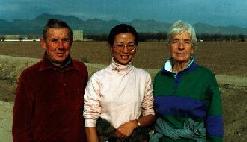
Dr. Layton "Jack" Horner, Cathy Chung and Marian Horner
|
My three-week exchange visit to libraries in the Kansai area of Japan enabled me to acquaint myself with the current Japanese library scene, under my stated goals of learning from my host country, its cataloging practices, library automation, Romanization standards, special collections and recording technologies. This overseas experience makes me appreciate our American library system and more importantly, it increases my awareness of sharing information, resources and our spirit of library cooperation with library communities abroad.
The following are some of the highlights from my visit to Japan:
- Robotics: (See transcript of oral report for the ASLA/AEMA Conference, Tucson, 11/3/89.)
- Recording technologies: I attended an "A/B Fair", sponsored by Elmo, leading Japanese manufacturer. The demonstration showed much advanced media equipment designed for the educational and research markets. These included compact OHP (overhead projector), solar zoom lens, programmable multi-set slide projectors, world processors with Japanese and foreign language transliteration capabilities, marine cameras, surveillance devices, etc.
Video production is very popular in Japan. Many of the libraries I visited are equipped with video production facilities. For example, the Hyogo Prefecture Library has a studio with sound stage for interviews, sophisticated audio recording equipment, and computer-assisted design video production. On the day of my visit, the A/V specialist was conducting a class on CAD for media technicians.
- Bookbinding and repair: This is the required course for the Library School program in Japan. My brief stay allowed me to enroll for three evening sessions at the Momyama Gakuin University. The instructor, Mr. Honjyo Toshio, who is a commercial bookbinder, demonstrated traditional Japanese bookbinding and repair technique for hardbound books. It was exhilarating to be a student again, especially to be armed with hammer and needle!
- Professional association: I was invited to speak briefly at the meeting of the Nippon Library Association Technical Processing Study Group. The Mission of the study group, whose members are practicing librarians in the Kansai area, was to investigate the theoretical aspect of a general thesaurus for Japanese libraries. As explained to me by Professor Tsutomu Shihota, an authority on Japanese cataloguing and classification system, the lack of standardized subject headings is an imminent problem for Japanese Libraries. The complexity of the Japanese language system, where kana or syllabary cannot show distinct word separation, makes it difficult to devise controlled vocabularies for subject access. The availability of shared international online databases compounded with the currrent trends of local OPAC development makes the present charge of the study group a timely one.
- Rare books: My visits to Tenri University in Nara and the Kyoto University offered glimpses of the wealth of special collections in Japan. The former institution has a collection of 7,600 items, of which 160 are designated as national treasures by the Ministry of Education. These are comprised of important works from the Jesuit Mission press in Japan, rare Japanese and Chinese manuscripts and books, movable woodblock type items, and European celestial and terrestrial globes. I was also delighted to meet Professor Canenko, a specialist in classical Chinese, who spoke impeccable Chinese to me.
The Kyoto University Library also has an equally impressive collection. The special collection is housed in a special room with cedar panelling constructed in the beautiful Japanese "azecura" style. Among the manuscripts, scrolls and maps, there is also a distinctive collection of samuari swords!
Through the Sister City Commission of Phoenix, I was able to visit our sister city of Himeji. Much to my surprise and amusement, I was also given a site tour, donning hard hat and white gloves, of the future Castle Research Center and Municipal Library which are under construction!
- "Bunko": These are small local libraries or reading rooms supported and operated by volunteers to foster a better reading environment for children. (Japan Library Association, 1986) Most of them are open only on Saturday afternoons. The "bunko" I visited was in the Homachi, an old district of Osaka. Although the collection is small, it is well-used, as the "bunko" has an inviting atmosphere. I saw some children reading in a low closet, where books were also shelved. The volunteer for the day of my visit was the priest from the district temple. He was teaching the children, mostly preschoolers, how to fold origami.
"A day in the life of a cataloger": With my background and interest in cataloguing, I requested an interview with Mrs. Oishi Sanai, European Language cataloger at the Osaka University. I discovered that we share the same operative jargons, from MARC, AACR2 ( R ), LCSH, OPAC, interface and headings. The primary differences in our work is that whereas it is OCLC for me, it is NACSIS-CAT for her. The National Center for Science Information System (NACSIS) is the national union bibliographic database in Japan.
Another highlight of my sojourn in Japan is the Tenth Annual Nippon Masters Championship Games in Wakayama. Even being a spectator, instead of an entrant, was equally thrilling experience for me. To conclude, I will advocate the Nike slogan of, "Just do it!" for all future applicants!
|